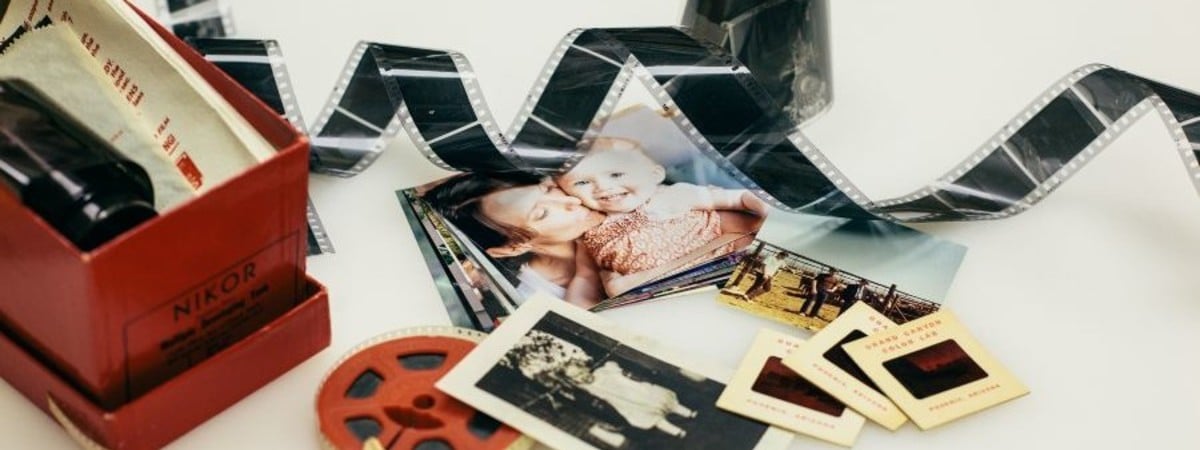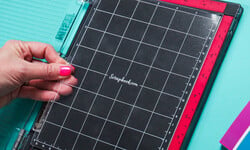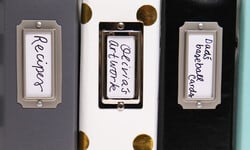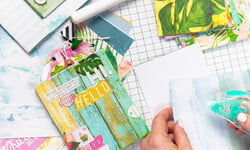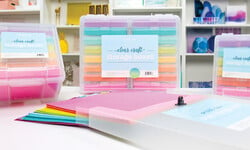Protecting your photos and historical items is like knowing the proper methods of skincare: when applied correctly the results are long-term and beautiful. Handled carefully, your memorabilia can look its best even after years of display. Knowing the right heirloom care can greatly influence where you spend your scrapbooking time, money, and effort. Here are fourteen facts every scrapbooker should know that can aid in heirloom longevity.
For a more in depth look at paper and photo preservation, take a look at our extensive research article on paper, photo and document preservation.
Liquids destroy memorabilia, photographs, and negatives.
To avoid disasters, store your scrapbook supplies, albums, photographs, and negatives in a dry, cool place away from water pipes, faucets, or plumbing. Liquid will destroy these valuable items. It's also a good idea to keep all drinks off your work area.
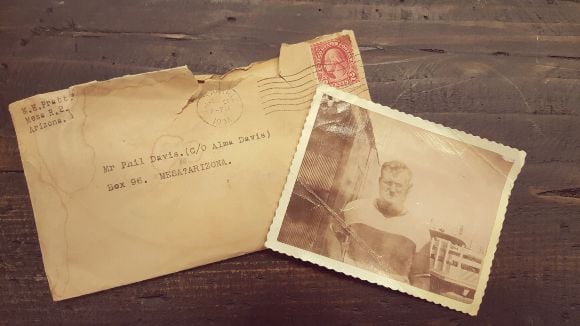
Sunlight causes damage.
Sunlight will eventually diminish photo, negative, layout and album quality. Keep all heirlooms out of direct sunlight.
Extreme temperatures create problems.
Extreme temperatures damage photographs, negatives, layouts, page protectors, and albums. Store all historical items in moderate temperatures and in locations where humidity is low.
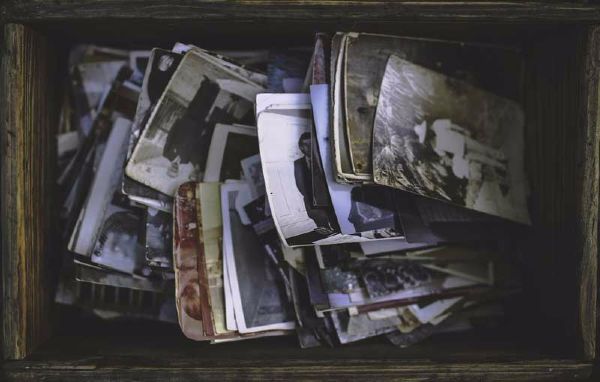
Fingerprints become visible over time.
Although not immediately apparent, fingerprints on photographs, negatives, and layouts become visible over time. Oil from skin is the culprit. To prevent this type of deterioration, handle photos carefully, touching only the outer edges. Second, wash hands frequently or use Acid Neutralizing Wipes, by UnDu. Third, follow the example of certain purists who wear lightweight cotton gloves, insuring their photos remain pristine.
Store and handle your items carefully.
Handle and store your photos, negatives, and layouts carefully. Improper storage increases the risk of scratches, tears, and bends. Store and seal your photos and negatives in a sturdy container, in plastic sleeves that fit into a three-ring binder, or in acid-free envelopes that have been labeled and filed. Layout storage should be doubly protected: first in sheet or page protectors, then in appropriate albums.
Some plastics can damage your items.
Not all plastics are alike. In fact, some sheet protectors, binders, photo enclosures, and photo corners will eventually damage your memorabilia more than if you had not used plastic protection or enhancement at all. The destructive material is polyvinyl chloride (PVC) or more commonly known as “vinyl.”
Because PVC is an unstable plastic, it releases a hydrogen-chloride gas that spreads to your memorabilia, corroding your photos and historical items over time.
To avoid this harmful process, do not buy materials containing PVC or its cousin polyvinyl acetate (PVA). Instead, look for acrylic or polyester (polyethylene and polypropylene) materials. They are chemically stable and will ensure encapsulation safety for your memorabilia. If you are uncertain of a product’s composition, you can easily identify PVC by its strong plastic odor.
Some paper is not acid-free.
Paper and cardstock found in your local scrapbook store are not necessarily acid-free unless so stated on packaging or company display-signs that reference your particular item. Also, though a manufacturer’s white and pastel papers are free of acid, that does not guarantee that their dark colors will be also. (Paper dies can affect the paper’s acidity level.) Your safest approach is to test any paper that is not specifically marked “acid-free.”
Detecting High Levels of Acid
Light Paper: A pH-testing pen is a great investment for any Scrapbooker wanting to ensure paper and products are acid-free. These pens contain a solution that changes color if the scrapbooking item contains acid. Manufacturers use different colored solutions to grade the severity of acid levels, so be sure to read the label instructions in order to determine the color(s) you should be looking for.
Dark Paper: PH testing ink will not show up on dark pigmented fibers thus affecting the pen’s reliability. To remedy this problem:
1. Test a piece of white cardstock with your pH-testing pen to make sure it’s acid free.
2. Take a scrap piece of the dark paper you want tested and rub it onto a small area of the white cardstock using significant pressure. (When you are through there should be a generous splotch of color in one small area.) Any acid from the paper or ink will have transferred itself onto the white cardstock.
3. Test the newly-colored area with your pH-testing pen.
Note: All of our papers and cardstock here at Scrapbook.com are acid free so you know your projects are safe.
Watch out for acidic items.
High levels of acid in ink, regular paper, newspaper, and other memorabilia amplify the acid level already present in your photographs through a process called acid migration.
Contact between scrapbooking items can cause chemical reactions, which affect the longevity and color of your photos. To deter this reaction from affecting your photos, keep a buffer of acid-free paper next to or behind your photos. Deacidification sprays such as Archiver’s Mist are available at most scrapbook stores. These sprays can neutralize acid in newspaper clippings and other historical items.
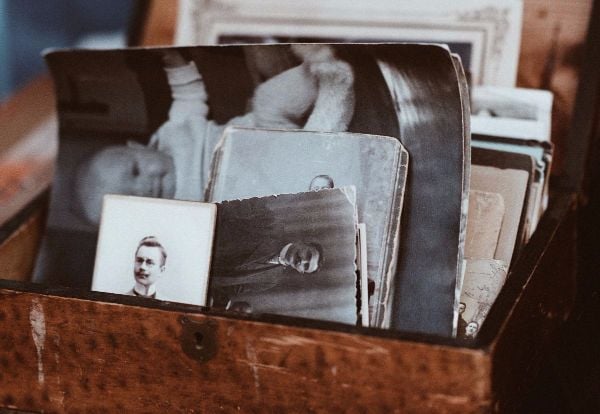
Avoid ballpoint pens on the backs of photos.
Photographs are put at risk when a ballpoint pen is used to document the names and dates on their backs. Because sufficient pressure must be applied when using a ballpoint pen, you may see impression marks on the front side of your photo. In addition, ballpoint ink transfers. If the photo is placed on top of a photo stack, ink blotting of other photos may occur.
Photos without dates are frustrating.
Photos without documented names and dates will one day become a burden or may even be discarded. Don’t procrastinate! Document your photos as soon as they are developed. If you have unmarked photos from years past take some time to put them in order with the proper names and dates.
If you find you are having difficulty remembering information, make a simple “year at a glance” history of your family. Include in it the age of each person, significant events, births, and deaths. Then as you organize your photos, you will have a point of reference to add to or start from. As you do this you can document history which benefits you now and your family for years to come.
Polaroid photos should never be cut.
Polaroids contain a necessary protective seal that allows your photo image to remain vivid over time. When this seal is broken, air enters behind the photograph nullifying the effects of the chemical process and causing your image to eventually disappear. If you have already trimmed your Polaroid photos and still have a visible image, color-copy or scan them immediately.
Professional portraits may not be replaceable.
If stored in acid-rich boxes, hung in picture frames with acidic mats, or exposed to significant sunlight, your portraits could be irreparably damaged. Professional photographers hold onto portrait negatives for a limited time (rarely more than 3 to 4 years, possibly less.) Copy shops will color-copy portraits only if the pictures lack copyright notices or written permission has been given by the portrait photographer.
In order to safeguard your photograph keepsakes, you can add the original portraits to layouts using acid-free materials (don’t crop them), use photo corners to secure them into place, and store them in acid-free page protectors in photo albums.
Alternatively, if you don’t want to place them in albums, store them in acid-free, size-appropriate, protective containers. It is also a good idea to scan and save all portraits onto computer discs. For large portraits, you can scan and stitch them together using a stitching program.
Don't lay albums flat.
For long-term album storage, never lay albums flat on a surface and stack them. Doing so will damage the album bindings as well as place harmful pressure on photos and embellishments. Line those albums up proudly in your bookcase and only lay them flat when displaying or reliving special moments.
Avoid magnetic photo albums.
Magnetic photo albums (albums that have sticky-pages covered in clear acetate) have an acidic adhesive that will severely damage or destroy your photos. If the adhesive imbeds itself into the backing of photos they can be difficult or impossible to safely remove from the page. If you have any photographs in this type of photo album, remove them as soon as possible and file for future scrapping. Your posterity will be grateful for the salvaged memories.
Tip: If your photographs seem permanently “stuck” on your page, carefully work a tightened strand of dental floss between the photo and the page or slightly heat your pictures with a blow dryer. If your photos are still immovable, color copy or scan the entire page and use the replicas in your scrapbooks. Store the original album in a safe place where it is dark, cool, and dry. You can read more tips on how to remove old photos from those sticky albums here.
Summary
An ounce of prevention is really worth a pound of cure. Giving your historic photos and memorabilia proper attention and care today can save you time, money, and energy tomorrow. Remember these fourteen safeguarding facts when determining your scrapbooking practices and help your heirlooms last beyond a lifetime!
You can take our free class "Learn How to Scrapbook" right here at Scrapbook.com and pick up more handy tips. If you'd like to learn more about the history of scrapbooking and how preservation techniques have evolved over time, you can view this informative "readable museum" on the history of the scrapbook album.

